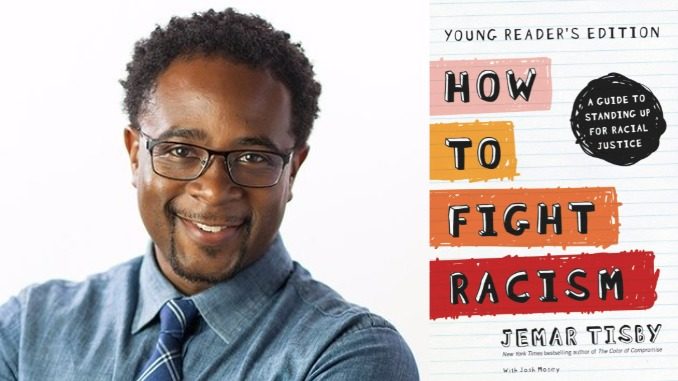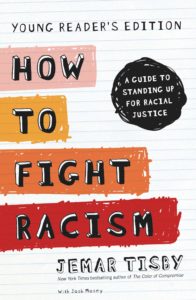
Podcast (beyond-the-page): Play in new window | Download
Subscribe: Apple Podcasts | RSS
The murder of George Floyd seemed like a watershed moment. More people than ever before were protesting, calling for justice, and ready to dismantle unjust systems. With that came an influx of a lot of people who maybe had good intentions but didn’t really know what to do it. To counteract that, Jemar Tisby wrote How to Fight Racism, a practical handbook that utilizes his ARC (Awareness, Relationships, Commitment) model to guide readers toward building a better world. A year later, Tisby has returned with How to Fight Racism: Young Reader’s Edition. Aimed at kids ages 8-12, Tisby takes the same model and commonsense practicality and adapts it for kids just becoming aware of and seeking to counteract injustice. I had that chance to talk to Jemar about the book and it was a wonderful and enlightening conversation.
The Conversation | How to Fight Racism
This interview excerpt may be lightly edited for clarity and brevity. Listen to the full podcast interview at the player above or wherever you get your podcasts.
Josh Olds: Probably the number one objection that I hear whenever we try to educate children on racism, like you’re doing here, is that they’re too young for these kinds of conversations. Obviously, you don’t believe that, but how do you how do you handle that sort of objection to even begin to get the conversation going?
Jemar Tisby: I think we’ve got to realize as adults that kids are aware of a lot more than we think they are. And they’re often aware—a lot more aware—of the topics we hoped they weren’t aware of. So it could be anything from sex to racism: they know a lot more than we think they do.
There’s a famous experiment called the Doll Test where scientists showed five-year-olds white dolls and black dolls, and asked them, which was prettier, which was uglier, or which was smarter, or, you know, all of this. And then—even at that age—kids, both black and white, exhibited preferences for or more favorable attitudes towards the white dolls and had more negative associations with the black dolls. And these are kindergarteners, first graders—so it’s already happening. Our kids are already being socialized to think in racial terms.
The other thing is, when kids ask questions, that’s the perfect time to talk about it. And kids can ask questions about skin color, and about why things are the way they are at a very early age. And it’s best to respond to those questions as best you can have rather than sort of ignoring them or shuffling them off to the side because it’s “inappropriate.” So our young people are a lot more prepared, or a lot more curious, or a lot more exposed than we realize they are. They probably heard of something like Black Lives Matter. They’ve understood the necessity of protests, as high schoolers are marching in the streets to protect themselves and their classmates from shooting sprees inside their own schools. They’re mad about te earth burning up and climate change and us adults just leaving them holding the smoldering remains of what was once a beautiful earth. So they’re already sort of tuned in to these broader issues of social justice and racism is a part of that.
Our kids are already being socialized to think in racial terms. – Jemar Tisby
Josh Olds: It seems like they are able, they’re willing; they need to learn, they need to be focused. It’s like any issue in life. But I think that if we can really train this generation and give them practical things to do, beyond just social media activism—actual practical things—they can make a difference, and that that’s where your book comes in.
Jemar Tisby: Absolutely. And I just want to make another point real quickly…I do think it’s important that as adults, we don’t buy into this idea that racism is really generational, and that young people are automatically going to be more aware and more progressive on racial issues. Like, you don’t just age out of it. I’ve been in so many conversations where people have basically said, you know, “What do we do about racism?” And the answer’s been: “Well, you just got to let this older generation die off, right?” They were they were born and raised in a context where racism was normalized, you’re not going to change their views, but young people, they get it, they’re more aware. And once these folks with these bad mindsets, you know, sort of enter retirement age and fade from the scene, it will be better.
That doesn’t happen. It doesn’t work that way. I’ll give you an example. I’m in the state of Mississippi, where I went to school for my PhD. There are all these historical markers for Emmett Till. And almost as soon as these markers go up, they’re vandalized, often by people shooting at them. They’re riddled with bullet holes. And in one of the most recent incidents, it was an Emmett Till marker that had gotten shot up. I’m not sure if there was cameras nearby or what, but they ended up catching the vandals, which almost never happens. And they were freshmen at the University of Mississippi, where I was getting my PhD. So, I mean, these are teenagers. There’s no sense in which they’re not part of this newer generation that is supposedly more racially enlightened. And yet, they’re still committing acts like this. So it’s not as simple as letting more young people be born and racism will take care of itself. So that’s why I do think it’s critically important that as adults, we really do take ownership of our own education and that of our children or young people when it comes to race.
It’s important that as adults, we don’t buy into this idea that racism is really generational, and that young people are automatically going to be more aware and more progressive on racial issues. – Jemar Tisby
The Book | How to Fight Racism: Young Reader’s Edition
 Racism and social justice are important topics kids are dealing with today. In this adaptation of How to Fight Racism for young readers ages 8-12, Dr. Jemar Tisby helps kids understand how everyday prejudice affects them and what they can do to create social change. Inside, he explains the history of racism in America and why it is so prevalent, as well as uses Christian principles to provide practical tools and advice kids can use to develop and maintain an anti-racist mindset and make a positive difference in the world.
Racism and social justice are important topics kids are dealing with today. In this adaptation of How to Fight Racism for young readers ages 8-12, Dr. Jemar Tisby helps kids understand how everyday prejudice affects them and what they can do to create social change. Inside, he explains the history of racism in America and why it is so prevalent, as well as uses Christian principles to provide practical tools and advice kids can use to develop and maintain an anti-racist mindset and make a positive difference in the world.
Racism is pervasive in today’s world, and in the wake of protests and a call for change, many kids are eager to confront it but aren’t always sure how. Jemar Tisby, author of How to Fight Racism and The Color of Compromise, believes we need to move beyond mere discussions about racism and begin equipping young people with the practical tools to fight against it.
In How to Fight Racism Young Reader’s Edition, Dr. Tisby uses history to explore how racism has affected America since before its founding and how it’s continued to grow, as well as examines how true social justice is rooted in the Christian faith. In a format that provides kids with a handbook for pursuing racial justice, readers ages 8-12 will discover:
- hands-on suggestions and real-world examples of change they can put into action
- practical ideas for confronting racism in their everyday lives, and how they can use Christian values to change the narrative around race
- the ARC of racial justice—Awareness, Connection, and Relationships—that help form an anti-racist mindset
- ways to evaluate their actions and promote biblical principles
Throughout, kids will learn how to ask questions of themselves and their communities as they stand up to racism in all its forms. This book is for anyone who believes it is time to courageously confront the racism we see in our society today.
The Author | Jemar Tisby
 Dr. Jemar Tisby is the author of the New York Times bestseller, The Color of Compromise, president and co-founder of The Witness: A Black Christian Collective, and co-host of the podcast, Pass The Mic.
Dr. Jemar Tisby is the author of the New York Times bestseller, The Color of Compromise, president and co-founder of The Witness: A Black Christian Collective, and co-host of the podcast, Pass The Mic.
He grew up just north of Chicago and attended the University of Notre Dame. He went on to join Teach For America and was assigned to the Mississippi Delta Corps where he taught sixth grade at a public charter school and later went on to be the principal. He received his MDiv from Reformed Theological Seminary and recently received his PhD in history at the University of Mississippi studying race, religion, and social movements in the twentieth century.
Jemar and his family call the Deep South home and especially love the weather, people, and food!
